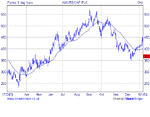There are many things that reportedly "work" for someone or someones or other, but which fail to measure up when tested. And there are many things that seem to "work", but when examined more closely are found to work for reasons other than those which are suggested. Spring comes, after all, whether one tosses the virgin into the volcano or not.
This business of dropping off old numbers is used in a number of applications, such as some calculations of the AD line. But, eventually, one arrives at a So What? Like taking your age and multiplying it and dividing it and adding and subtracting and including the loose change in your pocket and adding 115, it's easier just to remember how old you are and to count your change.

